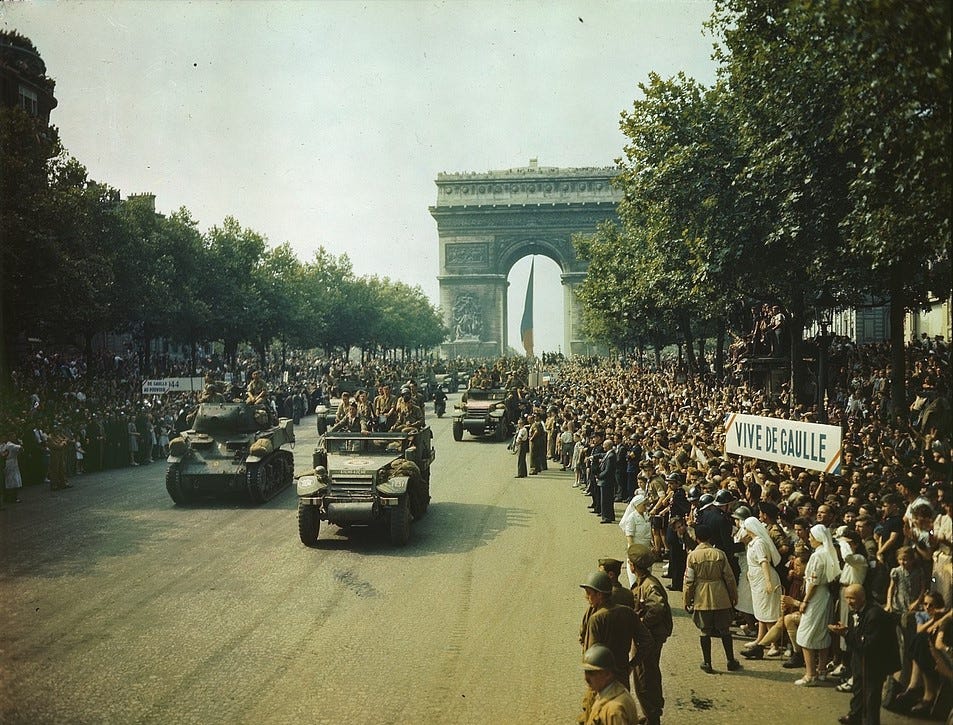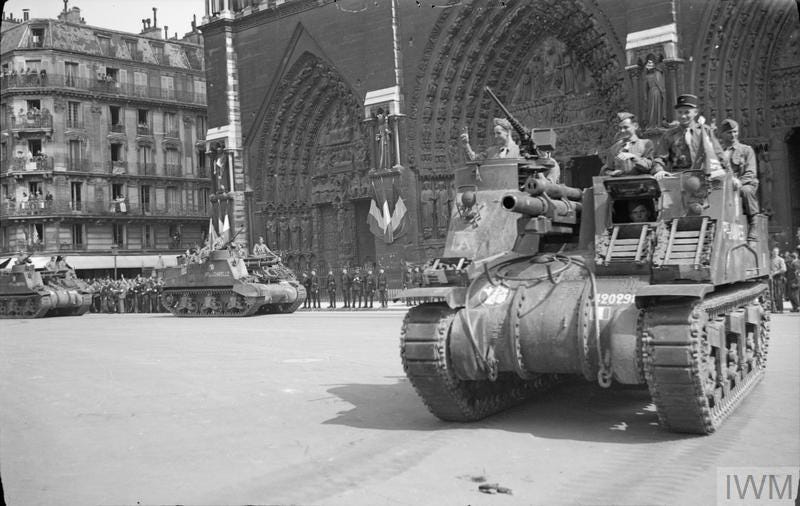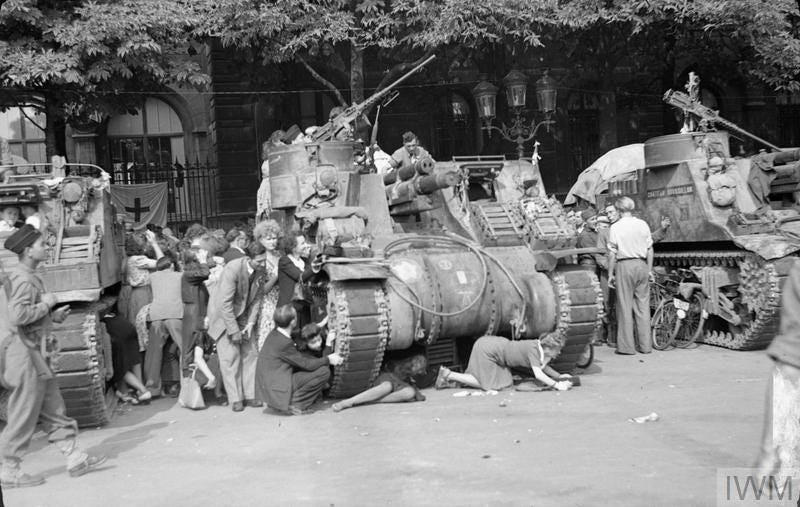Paris liberated: De Gaulle under fire

Liberation day in Paris was a sea of ecstatic crowds swarming French and American jeeps and armored vehicles as they rolled into the city along the grand boulevards -- even as pockets of German resistance remained in certain parts of the city.
The following day, August 26, was to be a more formal celebration of France reclaiming its capital. Ernie Pyle described the contrast:
The second day was a little different from the first. You could sense that during those first few hours of liberation the people were almost animal like in their panic of joy and relief and gratitude. They were actually crying as they kissed you and screamed, "Thank you, oh thank you, for coming!"
But on the second day it was a deliberate holiday. It was a festival prepared for and gone into on purpose. You could tell that the women had prettied up especially. The old men had on their old medals, and the children were scrubbed and Sunday-dressed until they hurt.
And then everybody came downtown.
The day's marquee event would be a parade led by the leader in exile, Charles de Gaulle, who strolled down the Champs-Élysées from the Arc de Triomphe to the Place de la Concorde and proceeded from there to Notre-Dame in a car.
Shortly after de Gaulle jumped into the vehicle, shots rang out from one of the buildings lining the route, prompting wild volleys of return fire from soldiers and tanks. The French leader showed no reaction to the outburst, continuing along on his route to the cathedral.

Several correspondents had set up at Notre-Dame to capture the moment, among them Robert Reid of the BBC. Reid's recorder rolled as he launched into a play-by-play of de Gaulle's arrival.
"The general has now turned to face this square and this huge crowd of Parisians..." he begins, before a burst of gunfire rings out.
Reid falters for a moment, then briefly attempts to continue before falling silent as more shots are exchanged. He tries once more to describe the scene before the recording drops out for a few seconds (the wire from his microphone to his recorder had been disconnected as people scrambled for cover).
Reid comes back on the air after the gunfire stops, calm and measured once again.
"Well, that was one of the most dramatic scenes I've ever seen," he says. "Just as General de Gaulle was about to enter the Cathedral of Notre-Dame, firing started all over the place. I'm afraid we couldn't get you the noise of that firing, because I was overwhelmed by a rush of people trying to seek shelter, and my cable parted from my microphone."

Daily Telegraph correspondent Douglas Williams reported that firing outside Notre-Dame continued for about 15 minutes, as friendly troops once again attempted to take out the snipers.
Just as General de Gaulle, fresh from his triumphal procession through Paris after laying a wreath on the tomb of the Unknown Soldier, had stepped from his car to enter the cathedral amid thunderous shouts from the enormous crowd filling the square, shots rang out, apparently from the cathedral roof.
Immediately the rifle of every Maquis, machine guns from scout and escort cars, and even small calibre guns from tanks opened fire on the spot whence the firing was thought to have come. The crowd panicked and broke, screaming, to seek the safety of the side streets. Women and children unable to escape sought refuge under cars, behind buttresses, or anywhere they could screen themselves.
De Gaulle and his party continued into the cathedral, with about 40 people rushing in behind them. Among them was Helen Kirkpatrick of the Chicago Daily News, who found herself a few feet behind Generals de Gaulle, Koenig and Leclerc before they began to walk down the center aisle with hats in hands. She described the scene:
Suddenly an automatic opened up from behind us -- it came from behind the pipes of Notre-Dame's organ. From the clerestory above other shots rang out and I saw a man ducking behind a pillar above. Beside me FFI men and the police were shooting.
For one flashing instant it seemed that a great massacre was bound to take place as the cathedral reverberated with the sound of guns.
It seemed hours but it was only a few minutes, perhaps ten, when the procession came back down the aisle. I think the shooting was still going on but, like those around me, I could only stand amazed at the coolness, imperturbability and apparent unconcern of French generals and civilians alike who walked as though nothing had happened. Gen. Koenig, smiling, leaned across and shook my hand.
I fell in behind them and watched them walk deliberately out and into their cars. A machine gun was still blazing from a nearby roof. Once outside, one could hear shooting all along the Seine.
Though Paris remained firmly in Allied hands, sporadic fighting continued throughout the city that day, the remaining Germans and French Milice attempting a desperate last stand against the liberators.
The attacks left a city primed for celebration on edge, dampening what had been set to be a celebratory day. The Australian correspondent Alan Moorehead, who had been inside Notre-Dame during the drama there, summarized the mood in his classic 1945 book, Eclipse:
It seemed unbearably sad that all this happiness had been turned so quickly into fear. Not many people were killed or hurt, but the shock was intense. No one had been prepared for so swift a return to the danger of the past week. They had no mental reserves for the ordeal, and they stood about on the pavements, white-faced and pathetic.
Presently as the firing died away they began to drift homeward, leaving the streets to the FFI and the soldiers and all the furtive things that were happening just then in Paris by night. Too much had happened too quickly. Paris that night lay prostrate in nervous exhaustion.



